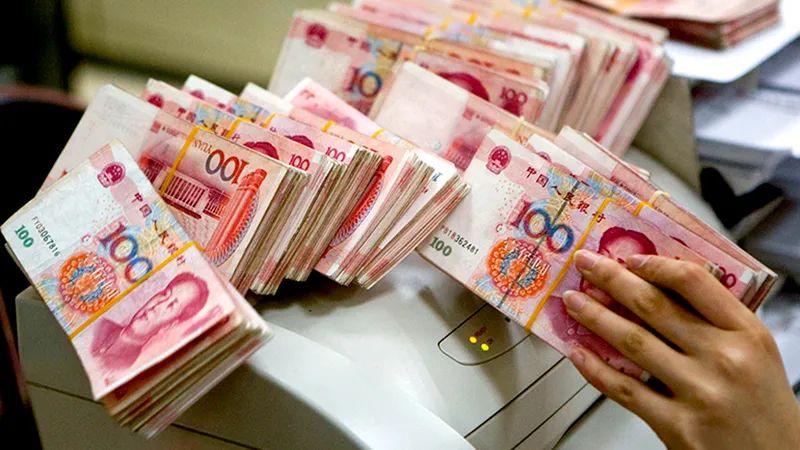The central bank has carried out 14 -day reverse repurchase, and the liquidity before the escort festival
Author:First financial Time:2022.09.27
27.09.2022

Number of this text: 2312, the reading time is about 4 minutes older
Guide: After the end of the season, the capital side will tend to be stable in October.
Author | First Financial Duan Siyu
Near the end of the season, the central bank has increased liquidity. Since the 14 -day reverse repurchase operation has restarted, the central bank has continued this operation recently, and the scale of operation has expanded. Wind data shows that from September 19th to 27th, the central bank invested a total of 245 billion yuan through 14 days of reverse repurchase operations.
Affected by factors such as cross -seasons, market capital interest rates have recently fluctuated. The 14 -day reverse repurchase operation is mainly to escort the liquidity before the festival. The chief economist of CITIC Securities clearly told reporters that the central bank happened to open a 14 -day reverse repurchase operation on the first day of the month of the month, proactively providing the monthly funds of the month, stabilizing the market expectations, and care for the fund at the end of the season.
In the eyes of many industry insiders, after the end of the season, the capital will tend to be stable and maintain a relatively balanced state. This is mainly to consider that compared with September, the impact of cross -seasons, tax periods and span -month overlap on funds at the end of October.
As far as the bond market is concerned, it is clearly estimated that the short -term long -term bond interest rate will maintain a low fluctuation trend. In the long run, the fixes of the economic fundamentals and wide credit during the year will determine the direction of the next trend.
Why restart for 14 days of reverse repurchase
Similar to previous years, the 14 -day reverse repurchase of this month arrived as scheduled. On September 19, the central bank launched a 14 -day reverse repurchase operation of 10 billion yuan and a 7 -day reverse repurchase operation of 2 billion yuan. The operating interest rate decreased by 10 basis points to 2.15%compared to before.
"From the perspective of the whole year, September is a key time window, and monetary policy operations often have many." A banking industry macro analyst told reporters that in history, in most cases, the 14 -day and above period of inverse repurchase was launched. All appear in the Spring Festival or the end of the quarter, mainly to hedge the impact of the issuance of government bonds, tax periods, financial institutions, and corporate income tax settlement.
Recently, market capital interest rate fluctuations have increased, and the funding for funds has converged slightly. According to the data of China Currency Network, as of September 27, the 7 -day inter -bank pledge repurchase weighted average interest rate (DR007) was 1.6931%. Although it decreased from 26 At the same time, the weighted average interest rate (DR001) has also been up to 1.38%overnight, and it has also rebounded significantly from the beginning of the month.
The uplink of capital interest rates has attracted market attention, but many people in the industry believe that this does not mean that the liquidity situation between banks will change. Liu Yu, chief analyst of the fixed income of Guangfa Securities, said that the amplification of capital fluctuations in September is a manifestation of balanced supply and demand status, and it may be difficult to return to the state of continuous sufficient capital from early July to early July to early August. The liquidity may enter a stage of a slight increase in the centrality of capital interest rates and volatility.
At the end of the season, because the deposit institutions are facing the MPA assessment, the liquidity supply of the inter -bank is tightened, and the market liquidity demand is strong. Therefore, the capital interest rate often shows a wide range of adjustments at the end of the quarter, and the rapid decline in adjustment after cross -seasons is completed.
"Since mid -September, there has been some adjustments in capital, but it has risen from a relatively low level at the beginning of the month, and there is still a large interest space for interest rates from the policy interest rate. Therefore, this round of adjustment in September is in line with market laws. At the short -term factors, the inter -bank liquidity and abundant environment has not substantially changed. "Obviously.
In this context, it is not surprising that the market restarts for the 14 -day reckless repurchase operation. Moreover, the 10 billion yuan funds operated on September 19th will be on the first working day after the National Day, that is, expires on October 8th, and it can just cross the end of September at the end of September.
Obviously, the central bank decisively restarted the 14 -day reverse repurchase operation on the first day of the 14 -day reverse repurchase operation, actively supplying the monthly funds of the month and stabilizing the market expectations; in addition, the rest of the week was put on The 14 -day reverse repurchase will also expire on October 8th, and it is expected that at least 90 billion yuan of reverse repurchase expiration on the day will be expired.
While the 14 -day reverse repurchase continued, the scale of the central bank's operations also expanded, from 2 billion yuan on the 19th to 93 billion yuan, in order to restrain the fluctuation of capital. From the perspective of market performance, after the inverse repurchase operation, the capital interest rate has declined slightly, and the bond market has strengthened. On September 27, Treasury futures rose slightly. The 10 -year main contract rose 0.06%, the 5 -year main contract rose 0.03%, and the 2 -year main contract rose 0.01%.
Earlier, due to the return of short -term market interest rates to policy interest rates, the pressure on the bond market adjustment increased, and the long -term interest rate continued to fluctuate and the short -end interest rate was obvious. Some analysts said that the capital interest rate center will not have trending up for the time being, but it is difficult to return to the previous low. In the context of liquidity margin convergence, the long end valuation will also cause a certain pressure.
Future capital will tend to be stable
The consensus in the industry is that under the hedging of the central bank's increase in the scale of reverse repurchase operations, the impact of cross -seasons on liquidity is relatively limited. After this time, October liquidity will tend to be stable and maintain a relatively balanced state.
"In recent years, the central bank's forward -looking, flexible, and effective public market operation has greatly suppressed the fluctuations of capital interest rates." Obviously, thanks to the central bank's flexible and appropriate use of open market operation tools. In recent years At present, the standard deviation of the 7 -day mobile annualization of DR007 has returned to near 2%. In addition, from recently, the central bank's shrinkage continues to do MLF (medium -term borrowing convenience) and restarted the 14 -day open market operation. It can be seen that the central bank's monetary policy still maintains a steady tone, providing a loose liquidity environment for economic restoration during the year. Obviously, on the basis of maintaining reasonable and abundant liquidity level, it is expected that the central bank will "make additional methods" to support the restoration of the real economy, and the policy level will still be expected. It is expected that after the end of the season, the capital side will tend to be stable.
Liu Yu also said that it is expected that the capital will maintain a relatively balanced state in October, and the overall may be slightly better than September. From a rhythmic point of view, the capital interest rate is expected to go up first, fluctuations or concentrated on the tax period of 25-27 and the 28th and 31st days of working days at the end of the month. The tax period is closer to the end of the month. The capital side has an additional impact.
Liu Yu further analyzed that she should pay attention to factors such as fiscal expenditure, MLF continuation, tax period, and government debt supply. For example, as a fiscal expenditure in September, the scale of public budget expenditures in the same period of the same period of previous years was about 2.4 trillion to 2.5 trillion yuan. This supplementary effect is expected It may be significantly lower than the last week of September.
In addition, in terms of MLF continuation, the MLF maturity in August and September both matched 600 billion yuan, and the central banks were renewed, with a scale of 400 billion yuan. In October, the MLF expired scale was 500 billion yuan, and the market had a certain degree of expectations for the reduction of MLF. Liu Yu said that if the central bank continues to shrink and does not decrease at the same time, after the MLF continues, the market liquidity expectations may occur may have marginal convergence.
In terms of tax period, in October, the taxation of the early quarter was the deadline for taxation on the 25th, and the tax period was available from 26 to 27. According to the statistics of Guangfa Securities, referring to the tax revenue data in previous years, the tax payment scale is 1.4 trillion to 1.5 trillion yuan, most of which are paid in the tax period. And only one working day at the end of the month on the 27th. The demand for funds at the end of the month and the end of the month is superimposed, or the capital interest rate fluctuates.
- END -
Reporters visit a number of small genius sales outlets in Wuhan: Children's tablets have been removed

Jimu Journalist Liu DongliVideo editing Liu DongliIntern Chen Yihan
The tide of the office hanging on the "Good overtime" slogan finally happened?

Since the beginning of this year, the layoffs have become the hottest topic in the...